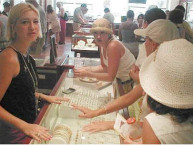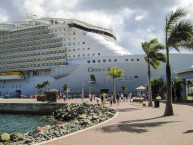Pearls
The most feminine of all jewelry, often known as the basic of any really fine wardrobe, the elegant pearl is enjoying a renewal  of popularity.
of popularity. Nothing is more dramatic or elegant than strands and strands of perfectly matched pearls.
Nothing is more dramatic or elegant than strands and strands of perfectly matched pearls.
Jackie Kennedy was famous for her taste in pearls.
Marilyn Monroe sang about “Diamonds being a girls best friend”. However in movies and in real life she was most often seen with a fine set of Pearls.
The colors range from pink, silver, cream, golden, green, blue and black. In size they can be the size of a pin head to a robins egg.
The typical pearly luster, also called the “orient” is a result of the overlapping of platelets of argonite and skins of conchiolin, which a humble little oyster produces to protect itself from an irritant.
Pearls are among the earliest of known gems which humans placed a value on. In China they were used to pay taxes.
Cleopatra, in an attempt to capture for herself the beauty of Pearl, dissolved one in vinegar and drank it. It is said that on another occasion, she wagered Marc Anthony that she could swallow the entire value of a province at one meal. With that, she took a perfectly flawless Pearl of enormous value, ground it into a fine powder, placed the powder in a glass of wine and swallowed it.
In Persia the wealthy had them carefully sewn into clothing. Pearls were exclusively used by Royalty thru-out the Middle Ages. In ancient Ceylon and India Pearls were closely associated with weddings, bringing good fortune and happiness to the couple. Today they are considered the jewel of choice for brides.
In China as early as the 13th century, small leaden figures of Buddha were affixed to the inner shell of the mollusk shell so that it would be covered in the pearl material.
During the 1700s and early 1800s, the growing middle-class in both Europe and the United States developed an interest in pearls—and had the money to buy them. By the mid-1800s, seed pearls had become the pearls of choice. Jewelers typically worked with seed pearls imported from India and China that had been strung on silk or, more commonly, white horsehair. The resulting pieces of jewelry were so delicate that they often resembled lace, and they were considered a symbol of purity and gentility.
Round pearls were first produced by the Swedish Naturalist Carl V. Linne, in 1761.
In 1893 the Japanese, K. Mikimoto managed to produce semi-spherical pearls. By 1920 the round cultured pearl, Akoya, was causing quite a stir in the Jewelry industry. Here was a pearl that was artificially helped along by man, when an irritant was inserted into the oyster, the oyster bed cared for over 18 months or so to produce a pearl. Many jewelers of that day did not consider this to be a “real Pearl”. Today Akoya Pearls are widely accepted in the Jewelry industry, making Pearls more available to everyone. They are Cultured Pearls, are of lower price than natural pearls and are a wonderful option for the beginning Pearl aficionado.
Jacques Cartier, the famed French Jeweler knew the value of fine Pearls and also the need of a good location for his business. The world is very familiar with his now legendary store on New York’s Fifth Avenue. What many do not know is that he paid for this location in 1916 by trading for it with two Pearl Necklaces.
Record Pearl Found Off Burma
A natural pearl, believed to be the world’s largest, has recently been discovered in the waters off Burma. The saltwater pearl weighs 845 carats. One of the largest previously known saltwater pearls is the 450 carat Hope Pearl, named after Henry Philip Hope.
The majority of pearls are strung and worn as necklaces. The usual length is 15 1/2 inches. Double lengths are called sautoirs.  Pearls are either matched for size to make a necklace or are graduated in size with the biggest in the middle and the smallest at the ends. The careful selection of the pearls for the necklace is done by eye.
Pearls are either matched for size to make a necklace or are graduated in size with the biggest in the middle and the smallest at the ends. The careful selection of the pearls for the necklace is done by eye.
The pearl is valued according to shape, color, size and luster. The most valuable is the spherical shape. Half-spherical pearls, or those flattened on one side are called bouton or “button” pearls. Irregular shaped pearls are baroque pearls.
Half-spherical pearls, or those flattened on one side are called bouton or “button” pearls. Irregular shaped pearls are baroque pearls.
Are All Pearls Round?
Only a small fraction of pearls are perfectly round. Pearls can also be pear-shaped (teardrop), button-shaped (one axis is flattened), baroque (irregular) and circlet (ringed). While the perfect rounds are the most valued, pearls of other shapes are still considered quite beautiful and valuable, provided that the luster is good and there are minimal flaws.
Keishi and mabes are also used in jewelry. A keishi (pronounced “KAY-shee”) is a natural, rice-shaped pearl (“keishi” is the Japanese word for “rice”). They are often used to accent cultured pearls.
Pearls are weighed in grains and today often in carats. The pearl is evaluated as follows: the weight is multiplied by itself which is called “once the weight”. This is then multiplied by a base price which takes into account quality and all other factors. For necklaces where a large number of matched pearls are required, the base price tends to be very high.
What are the three different types of pearls?
Natural, Cultured & Imitation.
What are freshwater pearls?
Cultured pearls are from the oyster family in the ocean or salt water. Freshwater pearls are from the mussel family and can be found in fresh water like rivers, lakes and ponds. Freshwater pearls are usually smaller, not round, and are much less expensive.
The word “pearl” without addition should only be used for natural pearls. Cultured pearls must be designated as such.
The Pearl trade employs a variety of trade names. Among them are the following:
“Oriental Pearls”- those found in saltwater mollusks of the Persian Gulf.
“South Sea” are grown off the coasts of Australia, Indonesia and the Philippines. Considered to be some of the most expensive of Pearls and some of the largest. They come in primarily whites, yellow, yellowish orange, blue and some black tones. The overtones are rose, green and blue. The oyster lives deep in the ocean and divers “freedive” anywhere from 10 – 80 meters to collect these oysters. The pearl takes about 3 years to develop. The harvesting of these oysters is highly regulated so as not to deplete this natural resource.
“Ceylon” or “Madras” pearls- fancy blue, green. or violet overtones on white or cream base.
“Biwa”-these are freshwater pearls from Lake Biwa in Japan. They have a higher luster and smoother than the Chinese freshwaters.
“Venezuela” pearls- white or yellow, more transparent than Oriental pearls.
“Tahiti” pearls- Tahitian pearls are known for their iridescent, vibrant, almost metallic colors, unique among saltwater cultured pearls. Though commonly called “black” pearls, Tahitian pearls are actually gray, to lighter or darker degrees. But, in addition, Tahitian pearls have the unique ability to display a variety of colors at the same time, shimmering about their surfaces in varying shades — colors such as Peacock, Eggplant — Green, Olive Green, Blue and Magenta. The most highly prized Tahitian pearls are those of the iridescent peacock and cobalt blue colors, followed by the rainbows, grays and gold’s. Other fancy Tahitian pearl colors may range from parchment, to lemon, to a golden-orange. Due to the rarity of some of the colors, they are a wonderful addition to your jewelry collection.
saltwater cultured pearls. Though commonly called “black” pearls, Tahitian pearls are actually gray, to lighter or darker degrees. But, in addition, Tahitian pearls have the unique ability to display a variety of colors at the same time, shimmering about their surfaces in varying shades — colors such as Peacock, Eggplant — Green, Olive Green, Blue and Magenta. The most highly prized Tahitian pearls are those of the iridescent peacock and cobalt blue colors, followed by the rainbows, grays and gold’s. Other fancy Tahitian pearl colors may range from parchment, to lemon, to a golden-orange. Due to the rarity of some of the colors, they are a wonderful addition to your jewelry collection.
“Australian” pearls- white with almost no overtone.
“Panama” pearls- usually black, grayish, or yellow.
“Freshwater” pearls- usually have strong colors and orient, fancy colors are common.
Grading of Pearls in regard to Nacre Thickness (GIA Standards)
Very Thick 0.5 mm thick on all pearls Grade A
Thick 0.5 mm thick on most pearls Grade B
Medium 0.35 & 0.5 mm on most pearls Grade C
Thin 0.25 & 0.35mm on most pearls Grade D
Very Thin 0.25 mm or less on most Pearls
Nacre is the “skin ” of the Pearl. It is basically a calcium carbonate based crystalline substance which an oyster excretes to coat a substance that is irritating it, like a grain of sand or a piece of shell. The longer this irritant is in the shell of the oyster, the thicker the nacre layer becomes. The thicker the nacre the more luxurious and mirror like the outside of the Pearl becomes.
While you are shopping for pearls view several strands of Pearls side by side. Ask what grades they are and notice the difference in the luster. The more brilliant the luster, the better the pearls. On really fine pearls you will notice that you can barely see the pearls for the shine. If the pearls are so dull that no light is reflected back, pass them up.
Check how the under tones of the Pearls goes with your own skin tone. Fair skinned individuals find a pearl with a slightly pinkish undertone to be very flattering.
Olive skinned, and dark skinned individuals will find Pearls with a silver overtone looks stunning.

Black Pearls are adventurous, conversation starters & subtly state for the wearer that they are well heeled and well traveled.
White pearls are a classic, and are generally chosen by individuals wishing to “make a statement” with their wardrobe and jewelry selection.
The trend for 2003 in pearls are multiple colors…. greens, pinks, blue, white etc in the same strand. The fashion world is stressing “fun Jewelry.”
Recently, one of our gemologists was asked to complete a quality report on a custom ordered piece from one of the CGI member stores in Key West, Florida. (Emerald Lady) Apparently a client had purchased a wonderful necklace of fine quality pearls. The proprietor of the store suggested that her husband should have a set of fine pearls to match hers. Apparently they attend a lot of formal events and he wears tuxedos quite often. The result was a breath-taking set of 9.0 mm peacock color Pearl button studs and a matching set of 10 mm pearl cufflinks.
Being a one of a kind piece, the craftsmanship involved, the matching of the pearls, the size of the pearls, they received the deal of the century and an item of jewelry that will be passed down for generations.
How do you tell the difference between a real pearl and a fake pearl (Plastic Pearl)?
This is the number one question from consumers. It is very difficult for the lay person to distinguish between Natural pearl and cultured pearl. But when it is a plastic pearl, it is not so hard. Normally plastic pearls are lighter or less in weight compare to cultured or Natural pearl of same size. It will not have small fine hair hole and specific gravity is also different. One technique to check between plastic and natural pearls is to run the pearl strand across your front teeth. If the texture is smooth, it is probably plastic. If you detect a bit of grittiness, it is probably real.
If you buy pearls from trustworthy people, then you will not get cheated and for your further satisfaction, you can ask for the certificate. Natural pearls are very costly, $150.00 to $500.00 per gram. In the case of Cultured pearls, they are 1/10th of Natural pearls and plastic pearls are 1/10th of price of cultured pearls.
So even from price, you can make out the difference. Good quality pearls always attract human eyes. And if you stare for a longer time, you will get a different feeling for Natural pearls than the cultured pearls
“What size of Pearl is right for me?”
Since Pearls are steeped in tradition there are a few rules that have been handed down for generations. But generally we advise to buy what YOU LIKE. But if you’d like to go with tradition, here it is:
5.5 mm – 6 mm = for girls aged 12 to 16 or an extremely petite woman.
6.0 – 6.5 mm = ages 16 – 24, perfect gift for sweet 16, graduation, from a grand-parent or Christmas. This one jewelry item encourages girls to dress well, and they love the attention “real pearls” bring.
6.5 mm – 7.0 mm = younger women and 30 and up. Very appropriate for first day on the job, Valentines day, Birthday, and Christmas. This is a starter set, as prices can run $600.00 to $1,500.00.
7.5 mm – 8.0 mm = Age 30 and up, this is considered the last size in the lower bracket. It’s a staple of any woman’s wardrobe… she can dress it up or dress it down. It’s not too showy, and it very tastefully exudes an image of importance — a classic for the upwardly mobile career woman. It also suits very well as a wedding-day gift or a wedding anniversary gift through the fifth year of marriage. Prices can range from $900.00 to $1,700.00.
8.0 mm – 8.5 mm = This is the starting line of the higher priced Pearls. This is generally for women age 35 and up, and generally screams “Successful”. Priced at $1500 to $3,000, it is the Red Corvette of the jewelry wardrobe. But we all know there are cars other than Corvette, so lets go on to the next level.
8.5 mm – 9.0 mm = Age 35 – 45 or extremely successful woman in her 30’s. Priced at $1,700.00 – $4,500.00 this is the set that exudes power, class, and success. This is the size Jackie Kennedy wore.
9.0 mm – 9.5 mm = This is the CEO’s strand. The Ferrari of Pearls, with a price tag of $2,000.00 to $10,000.00. For a woman in her later years or an extremely successful woman in her 30’s. Those who collect fine jewelry and love rare Pearls will love these.
9.5 mm – 10.0 mm = This is the rarest of all Pearl sizes, almost impossible to get, especially if finely matched, and so carries a high price: $6,000.00 to $34,000.00. Barbara Bush was often seen at State Dinners wearing hers.
Care of Pearls
Pearls need a to be carefully wrapped in a clean cotton cloth. Unlike other gems they need a bit of humidity around them to keep them lustrous. So don’t seal them into a moisture proof container.
Avoid contact with vinegar, ammonia (found in most commercial jewelry cleaners), bleach, ink, hairspray, perfumes and cosmetics. These substances will spot or break down the surface of the pearl.
When putting your pearls away it is suggested that you wipe with a hot damp towel to remove body oils.
You should wash your pearls on occasion. In mild soapy water, not detergent. After washing rinse in clear water and wrap them in a cotton towel to dry. You can use a soft brush to clean around the knots.
Have your pearls re-strung once a year by a trusted jeweler, this will avoid the catastrophe of having your precious pearls flying all over the restaurant some evening. Small pearls do not have to be knotted since the knotting detracts from the appearance.



